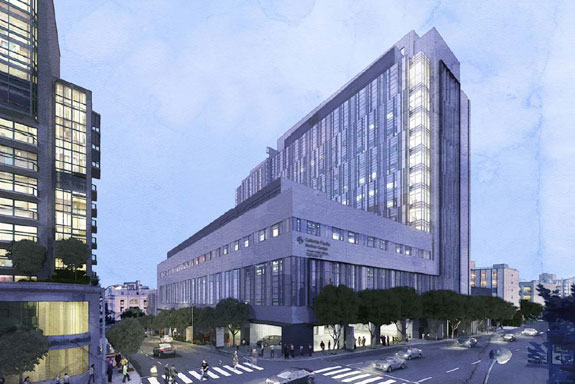San Francisco Mayor Ed Lee has sent a proposal to California Pacific Medial Center (CPMC) officials requesting more than $108 million to help mitigate the impacts of a proposed 555-bed hospital and office building on Cathedral Hill in the heart of a rich transit district and congested area that will be the future crossing point of two bus rapid transit (BRT) lines.
The mayor's proposal was first reported in the Chronicle this morning. It includes a request that CPMC contribute $73 million to the city's affordable housing fund, provide $4.5 million for the loss of 20 single-room occupancy (SRO) units and 5 rent-controlled apartments, along with $18 million for pedestrian safety and streetscape improvements in the Tenderloin and Mission, and $10 million for both the Van Ness and Geary BRT projects.
"It's certainly a good start," said Tom Radulovich, the executive director of Livable City, who has been a critic of CPMC's plans. "It's great to see some projects in there that have long been priorities for the adjacent neighborhoods."
As we've reported, transit advocates and a broad coalition of neighborhood and labor groups have raised serious concerns about CPMC's long-range development plans for San Francisco, including new parking being proposed for the enormous facility that would be built on Van Ness Avenue, and the plan for St. Luke's hospital in the Mission.
Advocates say the parking garages proposed for the Van Ness location (a total of 1200 spaces, 650 above current conditions) would have a detrimental impact on streets and neighborhoods in the area, including the Tenderloin. Radulovich and other advocates have criticized the Planning Department's Draft Environmental Impact Report (DEIR) and outdated EIR models that fail to consider how additional parking affects driving demand.
A copy of the Mayor's demands [pdf] obtained by Streetsblog doesn't go into great detail, but outlines some of the pedestrian safety and streetscape improvements that would benefit the Tenderloin, which has some of the highest rates of pedestrian fatalities and injuries in San Francisco.
The proposal includes:
- $3.5 million to fund the conversion from one-way to two-way traffic on Ellis and Eddy Streets between Leavenworth and Mason.
- $3 million to fund curb bulbs, crosswalk treatments and signal modifications at a number of intersections in the Tenderloin.
- $3 million to fund pedestrian lighting along several streets through the Tenderloin.
- $500,000 to fund a “Safe Passage Program” creating a designated safe walking route for children through the Tenderloin to BART.
- $1 million in capital funding for the establishment of a neighborhood CBD for the Lower Polk Neighborhood, and initial set of physical improvements "to be implemented by the CPD on an ongoing basis."
- $1 million to fund streetscape-related improvements in the Lower Polk neighborhood.
- $7 million to fund a series of streetscape, pedestrian safety and lighting improvements in the immediate vicinity of St. Luke’s in the Mission.
Similar to requirements that were placed on the parking garage for the upcoming City Place development on Market Street, CPMC would remit to the SFMTA a .50 cent fee for each peak hour entry and exit, and a .25 cent fee for each off-peak entry and exit at its parking garages.
We had several questions for the Mayor's Office about this proposal, but a phone call to Ken Rich of the Mayor's Office of Economic Development was not immediately returned.
Will $18 million really be enough to mitigate the true impacts on transit, pedestrians and bicyclists?
What about some of the shelved proposals that were included in the San Francisco County Transportation Authority's 2007 Tenderloin/Little Saigon report [pdf], including a recommendation to two-way Leavenworth and Jones Streets?
Why no money for bicycle improvements? A garage for the Van Ness facility would let out on Polk Street. Why not fund a protected bikeway on Polk Street? It's a heavily traveled bike corridor (Route 25 on the bike map) that serves as a major north-south connection.
While many questions remain about the Mayor's proposal, Radulovich said it was encouraging to see these kind of issues addressed at this point in the process.
"Mitigation measures like these being proposed by the Mayor's Office before the project goes through the entitlements process, rather than being brokered after the fact as part of an EIR appeal as happened with Cityplace, is definitely progress," said Radulovich.
CPMC has not had time to officially respond to the Mayor's Office, but a spokesperson told the Chronicle: "We have only just begun to review the document, but clearly this is an ambitious request of a nonprofit hospital that is trying to meet its legally mandated seismic obligations."
Stay tuned.






